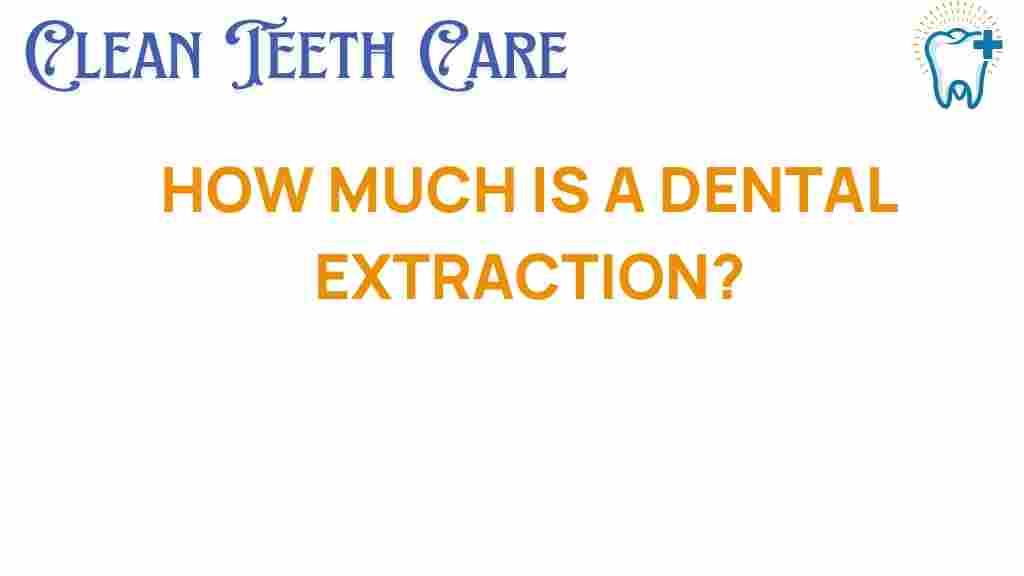The Hidden Costs of Dental Extraction: What You Need to Know
Dental extraction is a common procedure that many people may face at some point in their lives. While the immediate cost of the procedure can be straightforward, there are often hidden costs that can impact your overall expenses. In this article, we will delve into the various factors influencing the cost of dental extraction, including insurance coverage, dentist fees, anesthesia, and aftercare. Understanding these elements will help you make informed decisions about your oral health and dental care.
Understanding Dental Extraction
Dental extraction involves the removal of a tooth from its socket in the bone. This procedure may be necessary for several reasons, including:
- Severe tooth decay
- Gum disease
- Impacted teeth (such as wisdom teeth)
- Overcrowded mouth
- Dental trauma
Before undergoing a dental extraction, it is crucial to consult with your dentist to determine the best course of action for your specific situation.
The Initial Cost of Dental Extraction
The initial fee for a dental extraction can vary significantly based on several factors:
- Type of Extraction: Simple extractions (removing visible teeth) generally cost less than surgical extractions (removing teeth that are impacted or broken).
- Location: Dental fees can vary based on geographical location. Urban areas may have higher costs compared to rural clinics.
- Experience of the Dentist: An experienced dentist may charge higher fees, but they often provide better outcomes.
On average, the cost of a simple dental extraction ranges from $75 to $300, while surgical extractions can cost anywhere from $150 to $650 or more.
Insurance Coverage and Dental Extraction Costs
Insurance can significantly affect the overall cost of dental extraction. Most dental insurance plans cover a portion of the fees, but the extent of coverage can vary:
- Type of Insurance: Some plans cover extractions fully, while others may only cover a percentage of the fees.
- Deductibles and Copayments: Be aware of your plan’s deductible and any copayment requirements that may apply.
- Pre-authorization: Some insurance companies require pre-authorization for certain dental procedures, including extractions.
Before undergoing the procedure, it is advisable to contact your insurance provider to understand your coverage and any potential out-of-pocket expenses you may incur.
Anesthesia Costs During Dental Extraction
Anesthesia is an essential part of the dental extraction process. The type of anesthesia used can influence the overall cost:
- Local Anesthesia: This is the most common form used for simple extractions and is usually included in the extraction fee.
- Sedation or General Anesthesia: For more complicated extractions, such as surgical extractions, sedation or general anesthesia may be required, which can add $200 to $800 or more to your total bill.
Discuss with your dentist the type of anesthesia that will be used and how it affects the overall cost of the procedure.
Aftercare: A Hidden Cost of Dental Extractions
Aftercare is a crucial component of the dental extraction process. Proper aftercare is necessary to ensure a smooth recovery and to prevent complications. However, it can also contribute to the overall cost:
- Follow-Up Visits: You may need to return to the dentist for follow-up appointments, which can incur additional fees.
- Medications: Pain relief and antibiotics may be prescribed post-extraction, leading to added pharmacy costs.
- Possible Complications: If complications arise (such as infection or dry socket), further treatment may be necessary, leading to higher expenses.
It is essential to follow your dentist’s aftercare instructions carefully to minimize the risk of complications and additional costs.
Step-by-Step Process of Dental Extraction
Understanding the dental extraction procedure can help alleviate anxiety and prepare you for the costs involved:
- Consultation: Your dentist will evaluate your oral health and determine if extraction is necessary.
- X-Rays: X-rays may be taken to assess the condition of the tooth and surrounding bone.
- Anesthesia Administration: Local anesthesia or sedation will be administered based on the complexity of the extraction.
- Extraction: The dentist will carefully remove the tooth using specialized tools.
- Post-Procedure Instructions: After the extraction, you will receive aftercare instructions to follow.
Troubleshooting Common Issues After Dental Extraction
After your dental extraction, you may experience some common issues. Here are some troubleshooting tips:
- Pain Management: If pain persists, consult your dentist. Over-the-counter pain relievers may help, but always follow your dentist’s recommendations.
- Bleeding: Some bleeding is normal. If it continues for more than a few hours, contact your dentist for advice.
- Infection Signs: Watch for symptoms like fever, increased swelling, or pus. If you notice these signs, seek medical attention immediately.
- Dry Socket: If you experience severe pain days after the extraction, you may have a dry socket. Contact your dentist for treatment options.
Being proactive about your recovery can minimize complications and additional costs associated with your dental extraction.
Conclusion: Planning for the Costs of Dental Extraction
Dental extraction is a procedure that may be necessary for many individuals, but it’s essential to be aware of the hidden costs involved. From the initial cost of the procedure and anesthesia to aftercare and potential complications, understanding these factors will aid in better planning for your dental care.
Before proceeding with the extraction, consult with your dentist and ensure you understand the full scope of costs, including what your insurance will cover. By being informed, you can make the best decisions for your oral health and financial well-being.
For more information about dental procedures and costs, visit this resource. If you’re looking for a dentist, check out this directory to find one in your area.
This article is in the category Treatments and created by CleanTeethCare Team
